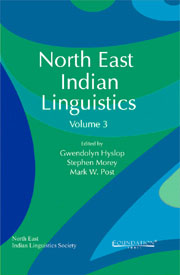8 - Functions of Nominalization in Karbi
from Tibeto-Burman Nominalization
Published online by Cambridge University Press: 26 October 2011
Summary
Introduction
This paper is a comparative approach to functions of nominalization in Karbi (formerly called Mikir/Arleng), a Tibeto-Burman (TB) language from Assam in central North East India (NEI). Nominalization and its various functions is a topic of considerable current interest in TB studies, and one with both typological and historical implications. There may be several nominalization constructions with deep roots in TB, including nominalization with the kV- prefix, as found in Karbi, and nominalization with the post-verbal particle -pa, which is widely attested in the family. There is still disagreement as to where Karbi fits into the family. It is often classified as particularly close to Meithei (DeLancey 1987: 800), but other scholars prefer to place it in a branch by itself (Burling 2003: 187). Both approaches acknowledge resemblances between Karbi and the different groups of “Naga” and Kuki languages, even though those are spoken in far eastern NEI. The status of these resemblances for the genetic classification has yet to be determined. While this paper is primarily descriptive rather than comparative, I have included data from two other TB languages of NEI: Angami Naga (Tenyidie), where we see the same velar prefix as in Karbi, and Meithei (Manipuri), putatively closely related to Karbi, but using the -pa nominalization construction instead of the velar prefix.
The outline of this paper is as follows: §2 is devoted to derivational nominalization, including the derivation of nouns that denote activities, states, or events, and the derivation of agent nouns.
- Type
- Chapter
- Information
- North East Indian Linguistics , pp. 120 - 134Publisher: Foundation BooksPrint publication year: 2011
- 1
- Cited by



